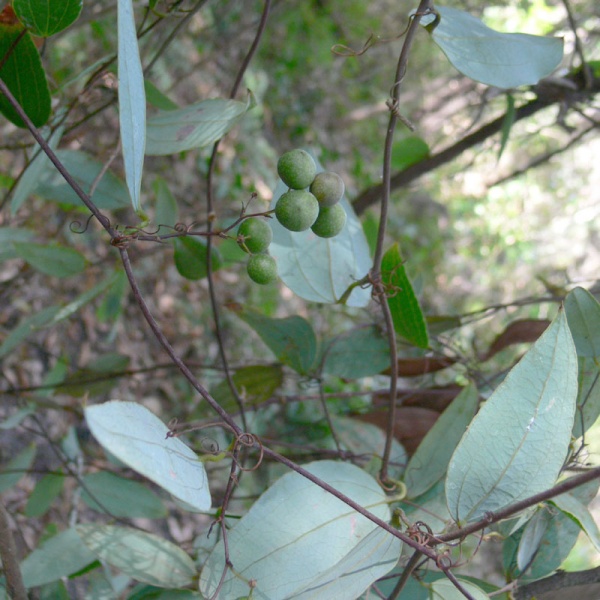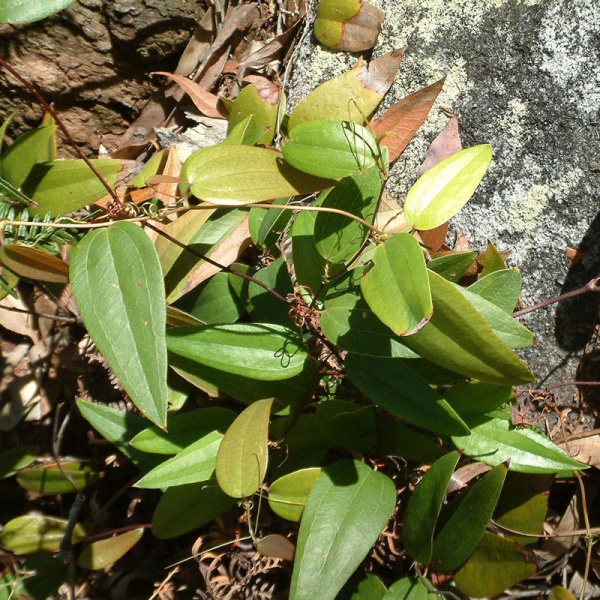Scientific Name: Smilax glyciphylla
-
Pronunciation:SMILE-axe gly-see-FILL-ah
-
Common Name:Sweet Sarsparilla



-
Type:
-
Family:SMILACEAE
-
Vegetation Type:Wet Eucalypt Forest,
-
Species List:EdingtonDr, Cooroibah, Bush food, Craft, Bush medicine, FI Podberscek, Wooroi Day Use Area Tracks, NNP Parkedge/Alex, NNP service road, Cooroibah26.4.09, Wooroi Palm Grove, Cooloothin Corner, Fraser Island, Stratford Park, Cranks Creek, NNS, Boreen Point, TAFE, Dandaloo, Noosa River NP, BHNR, Upper Yandina Creek, Heritage Park
Cultural Notes
TAKE CARE! Some information about bush foods and medicines may be anecdotal. Correct identification and preparation is essential:
Bush medicine: 'Leaves and stems provide a cure-all and a general tonic reputed to relieve colds, flu, coughs, bronchitis, arthritis, rheumatism and diabetes. The new leaves can be sucked to ease a sore throat'; use with horehound for 'good blood medicine' (Wreck Bay Community & Renwick, 2000:37) 'It cures internal pains like belly-ache. … boil up the water, put the leaves in it and let it boil … let the leaves go cold … you bottle it. People are selling it now for bush medicine and some people have been using it for cancers.' (Stewart & Percival, 1997:11)
Bush food: ripe black fruits eaten raw.
Older stems used for firesticks.
Bush Food, 'Leaves refreshing to chew.' (Wrigley & Fagg, 1998:615) Leaves used as tea substitute in early days of New South Wales settlement (Cribb & Cribb, 1987:207) Aboriginal Use: Aboriginals chewed the leaves and ripe black fruits for coughs and chest complaints. They contain glyciphyllin which has a bitter sweet taste and may be responsible for the plants medicinal properties. The Aboriginals first choice were the tender new growth leaves which are pink in colour and less bitter than the older tougher leaves. Some Aboriginal people still use this plant, they boil leaves in water then let stand until cold. The fluid is then bottled and used when needed for upset stomach. Some Aboriginal people have even used this for internal cancers. In 1790 Surgeon - General, John White recorded that this plant is a good general tonic and scurvy preventative. An infusion of the leaves (tea) was consumed during the early colonies to help in the prevention of scurvy (vitamin C deficiency). During the 1800Çs it was a common article of trade amongst Sydney Herbalists, being used as a general tonic and also for coughs and chest complaints. The leaves were exported to China from the 1840Çs to 1870Çs for its medicinal properties. In 1871 Naturalist T.W. Sheperd published in the NSW medical gazette his astonishment at the fact that we were importing a South American sarsaparilla for use as a general tonic and antiscorbutic (to treat vitamin C deficiency) instead of using our native sarsaparilla which he believed to be superior.
Identification Notes
Stems not prickly; leaves with 3 longitudinal veins, lower surface glaucous; tepals 1--2 mm long||
Associated Fauna
Butterflies: Miskin's Jewell
Landscaping Notes
Rockery scrambler. part shade.||


